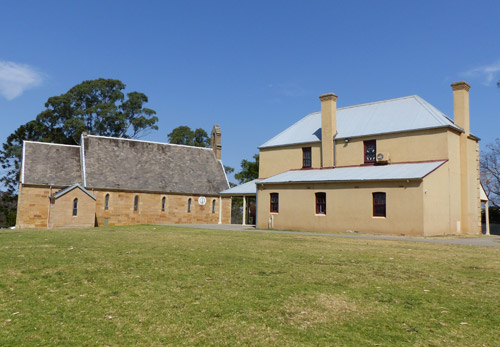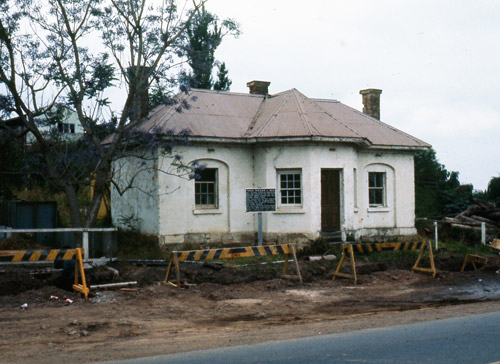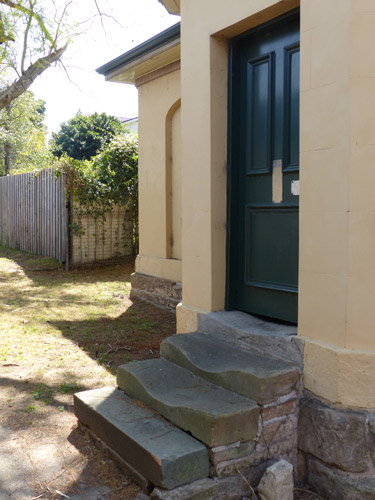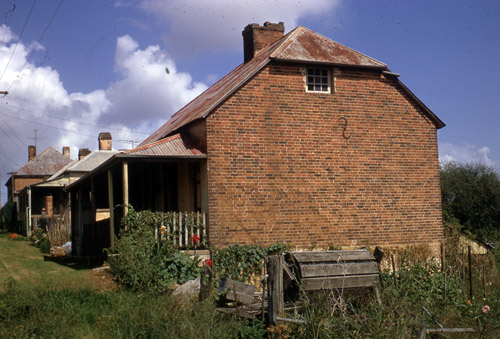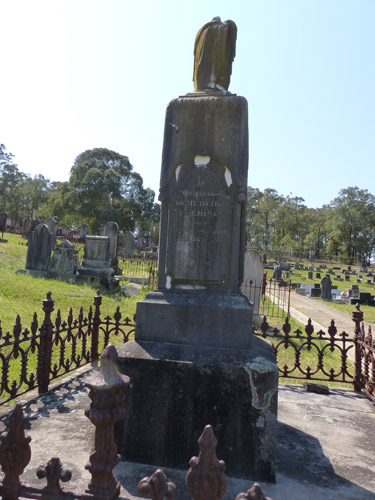[et_pb_section bb_built=”1″][et_pb_row][et_pb_column type=”4_4″][et_pb_text _builder_version=”3.0.106″ background_layout=”light”]
I still have fond memories from the early 1970s when I took various school groups on excursions to Windsor. This Hawkesbury River township on Sydney’s fringes has retained many of its historic buildings. The old Toll House next to South Creek is one of them and is always worth a visit.
[photo: early 1970s Toll House – © Jim Low]
This three roomed building, possibly the second toll house on the site, was erected in 1835 to manage the toll bar and so collect payment for the service provided to road travellers. Tolls had been collected from this site since 1802. The Toll House’s protruding entrance, with its two windows, afforded the toll keeper a clear view of travellers approaching either way. The worn, stone steps at the entrance attest to the many people who used the Toll House during its working life.
[photo: worn Toll House steps – © Jim Low]
Like today with the new Sydney toll roads increasing travel costs, whether the nineteenth century travellers believed that they were getting their money’s worth was debatable too. Despite an upgrade of the roadway at the instigation of Governor Macquarie in 1813, contemporary accounts are often scathing of the road’s general condition.
Today the Toll House is literally overshadowed by the present roadway. The high approach leading to Fitzroy Bridge, which now crosses South Creek, has erased any sense of meaning that the old building’s original use might have once had in the landscape. The same is true for the only other surviving toll house in New South Wales at Mt Victoria on the Blue Mountains. Recent roadwork changes have also diminished that building’s historical significance.
[photo: Toll House below roadway – © Jim Low]
Before the roads, the Hawkesbury River provided a practical pathway to Sydney. With the development of overland routes, the region’s sense of isolation was reduced. However, the river has still found a way of isolating the region. Over the years, floods have impacted significantly on the Hawkesbury. The Toll House itself was severely damaged in 1864 by flood waters.
A walk around the neighbouring streets reveals indications of the dangers of flooding in the minds of house builders. Walk down past the Court House and view the old homes positioned above the flood plain.
[photo: attic flood window 2017 – © Jim Low]
I returned to seek out one of these houses which I remembered from years ago. I first took a photograph of it in 1972 because of a single window positioned high on a side wall. This seemed to be the escape route onto the roof when the water inundated the home. Notice in my 1972 photograph the wooden potato washer on the fence.
[photo: potato washer and flood window early 1970s- © Jim Low]
In the same year that the Windsor Toll House opened, a baby was born in this market town. Fred Wordsworth Ward was the son of a convict who had been sentenced to transportation for life. Fred was educated at the Macquarie School House, still standing behind St John’s Church at Wilberforce. He was to become the notorious outlaw Captain Thunderbolt.
[photo: St John’s Church and school house in Wilberforce- © Jim Low]
Another not so well known ‘currency lad’ from this area lies in the St John’s cemetery at Wilberforce. John Henry Fleming, was born in 1816 into a free settler family who worked the land at Pitt Town. In 1838, three years after the erection of the Windsor Toll House, Fleming led a group of stockmen to Myall Creek. There they massacred around thirty Aboriginal people, mainly women and children. He fled the law, never taking responsibility for his part in this terrible crime. Returning to the Hawkesbury after a period of ‘lying low’, he seems to have reinvented himself. He died in 1894, a respected, married member of his community. His funeral at St John’s Church, where he was a deacon for many years, was apparently very well attended.
[photo: Grave of John Henry Fleming- © Jim Low]
These recent Hawkesbury wanderings continue to excite passions first experienced over four decades ago. The area still has the charm to draw to it those fascinated by local history and wishing to discover more.
© Jim Low
[/et_pb_text][/et_pb_column][/et_pb_row][/et_pb_section]

